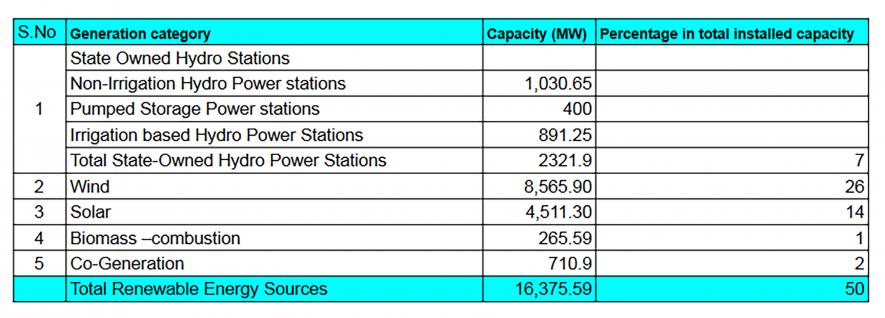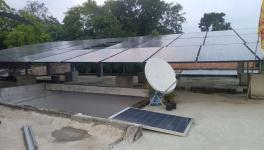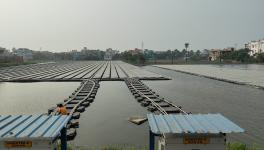TN Counters Coal Shortage With Reliance on Renewable Energy and Power Purchase
Representational use only. Image Courtesy: The Financial Express
Tamil Nadu has not felt the impact of the coal shortage so far because of its dependence on diverse energy sources and power purchases. The state government and the minister for electricity have assured zero power cuts in the event of coal stock depletion.
The available coal stocks could last for 2.8 days, while the thermal power stations (TPS) are expecting the restoration of coal stocks shortly. The state government has also requested the NTPC and Neyveli Lignite Corporation of India Limited (NLCIL) to restore the shutdown units to compensate for any gap in the demand and supply.
The state-run thermal power stations have a capacity of 4,320 MW out of the 16,219.47 MW from conventional energy sources, which also includes private purchase of 4,013 MW. The state has almost 50% contribution from renewable energy sources, i.e 16,375.59 MW out of the total installed capacity of 32,595.06 MW.
The Tamil Nadu Generation and Distribution Corporation Limited (TANGEDCO) is in a debt of Rs 1.07 lakh crores, allegedly due to excess pricing on purchases from private vendors.
DEPENDENCE ON TPS LOW
The state has an average power demand of 15,000 MW, while the demand is expected at 17,000 MW during the summer peak. The highest demand so far was reported on April 4, 2021, with 16,846 MW. The average daily demand for 2020-21 is estimated between 290-300 million units.
TPS contributes 13% of the installed capacity depending on conventional energy sources. However, 12 units with 210 MW capacity each (total 2,520MW) in Mettur, Tuticorin and North Chennai are over 25 years old and need immediate replacement.
Five TPS across the state are in various stages of completion with a total capacity of 5,700 MW.
Capacity From Conventional Energy Sources
Source: 2020-21 Policy Note of Energy department, Govt of TN. (Image: R Prakash)
Central generating sources contribute 20% of the total share while private purchases comprise 13% of the total capacity.
Moreover, the state has recorded a fall in the average plant load factor, thanks to the supply from renewable energy sources, mainly from private players.
DEPENDENCE ON RESOURCES
The state is one of the pioneers in exploring renewable energy (RE) sources, with wind energy generation playing a crucial role. Tamil Nadu is home to 25% of the total installed wind power generation capacity.
The state has its own installed capacity of 8,565.90 MW, contributing 26% of its total installed capacity. Solar power and hydropower stations contribute 14% and 7%, respectively.
Capacity From Renewable Energy Sources

Source: 2020-21 Policy Note of Energy department, Govt of TN. (Image: R Prakash)
High wind power generation is helping Tamil Nadu enter an agreement under swap power arrangement. From June to September, electricity generation would be high from wind power mills which is received during February to May, the low wind season.
The state has 8,569.90 MW of wind energy generators (WEG), while the TANGEDCO owns WEG of 17.465 MW. Further, 2,397 WEGs with a capacity of 2,145.67 MW are for sale to TANGEDCO.
The installed capacity of hydropower stations account for 14% of the total capacity, but have very low plant load factor. Since 2010-11, The plant load factor of 47 hydropower stations with 107 machines with a total capacity of 2,321.90 MW has remained below 29%.
Though the state has high installed capacity, the utilisation of the resources has remained poor, leading to the purchase of power from private entities.
PRIVATE POWER PURCHASES AND ALLEGATIONS
TANGEDCO has 11 long term power purchase agreements for 2,830 MW round the clock. Eleven companies based in Maharashtra, Chhattisgarh and Jharkhand are supplying electricity to the tune of 2,830 MW as per the long term open access (LTOA) plan. These agreements signed in 2013 will expire in 2028.
There are few medium and short term open access agreements to compensate for the sudden drop in power generation.
The policy note also claimed that the TANGEDCO has an outstanding loan of Rs 1,34,119.94 crore through different factors, including revenue gaps.
A reason cited by the state government for the loss incurred is the higher cost of production from TPS owned by the TANGEDCO. “But the TPS are being shut down frequently and operated with much lower efficiency,” said Jai Sankar, president of Central Organisation of Tamil Nadu Electricity Employees (COTEE).
“The average load factor of the thermal stations is very low, around 30% most of the time. With this output, calculating the cost of a unit generated is high, which is illogical. We suspect that the shutdowns are done intentionally to facilitate private purchases without upgrading and maintaining the existing plants,” Jai Sankar added.
In a press meet, the state minister for electricity, V Senthil Balaji said that TANGEDCO had increased its thermal power station’s generation from 1,800 MW in the previous AIADMK regime to 3,500 MW in the last five months.
The claims of the COTEE and the state government point to irregularities in power generation under the previous regimes. Though successive state governments have claimed that the state is self-sufficient in meeting the energy requirements, purchasing power from private players at an allegedly higher price remains a problem.
An effective revamp plan, utilising existing sources and tapping renewable energy sources can alone make the state self-reliant.
“The threat of privatisation of electricity generation and distribution is looming large with the BJP-led central government choking the state governments by creating coal shortage,” alleged Jai Shankar.
Get the latest reports & analysis with people's perspective on Protests, movements & deep analytical videos, discussions of the current affairs in your Telegram app. Subscribe to NewsClick's Telegram channel & get Real-Time updates on stories, as they get published on our website.
























